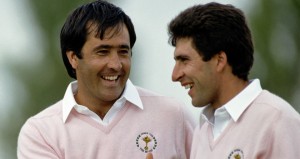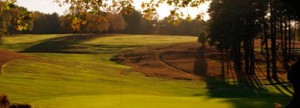Foursomes
The Ryder Cup always serves as a reminder of how great the foursomes format is and how, for the large part, it has become something of a lost art in club golf. Before you email me with detail of your frequent foursomes matches, let me start by saying that I’m not here to lament the loss of this form of the game – I’m aware a large number of clubs hold regular foursomes competitions and some more traditional clubs even make it mandatory for groups of four.
What I’m thinking about is regular, social golf, outside of competitions. Be honest, when was the last time you saw a group of four golfers head off down the fairway with only two balls in play? OK, out of bounds might have you saying “pretty often” but you get my point. Four players nearly always mean four balls and I can’t help but wonder why?
 I know there are the usual concerns: that foursomes play only allows you to play half the shots and therefore half the course; you don’t complete a scorecard; get a partner on their off day and you’ll spend your day chipping out from under the trees, playing out of bunkers, having to make five foot putts for a half. But it isn’t without reason that foursomes is one of the more celebrated formats having been responsible for some of the Ryder Cup’s greatest moments and pairings. Many of games greatest exponents – think Olazabal & Seve, Montgomerie & Langer, Donald & Garcia – have loved it, enjoying some of the highest points of their careers playing this format. And while we won’t all play in the Ryder Cup, we can all share the enjoyment of foursomes.
I know there are the usual concerns: that foursomes play only allows you to play half the shots and therefore half the course; you don’t complete a scorecard; get a partner on their off day and you’ll spend your day chipping out from under the trees, playing out of bunkers, having to make five foot putts for a half. But it isn’t without reason that foursomes is one of the more celebrated formats having been responsible for some of the Ryder Cup’s greatest moments and pairings. Many of games greatest exponents – think Olazabal & Seve, Montgomerie & Langer, Donald & Garcia – have loved it, enjoying some of the highest points of their careers playing this format. And while we won’t all play in the Ryder Cup, we can all share the enjoyment of foursomes.
For those unfamiliar, foursomes consist of two pairs of two golfers competing against each other using only one ball per team. Essentially you play alternate shots, with each partner also taking turns to tee off (ie one plays the even hole tee shots and the other the odd holes). There are, of course, many keys to a successful partnership – consistency, keeping the ball in play, maintaining a healthy relationship, and the unwritten rule of never saying ‘sorry’ being among them.
The intricacies of the game extend to ensuring you play to your partner’s strengths, as well as your own. Equally, your own performance is heavily influenced by that of your playing partner. There are subtle tactics to consider too, for example, it’s worth working out who is the stronger driver of a golf ball so that you ensure that player tees off on the more challenging driving holes. Equally, a good iron player may be better suited to the par threes. There are also peculiarities that the player has to adjust to, for example it’s quite common for one player not to putt for several holes in succession. It is arguably the most difficult format, but can also be the most enjoyable.
It is also quicker (usually taking no more than 3 hours to get round), and can be an excellent way of introducing new players to the game. Beginners paired with an experienced golfer can actively take part, watch, and learn from their partner.
 Many of the highest regarded golf courses in the UK & Ireland favour foursomes as the game of choice. It’s arguably golf in its purest form, where a brisk game of matchplay in the company of a trusty partner followed by lunch in the clubhouse, is difficult to surpass. For the energetic, the prospect of playing another round in the afternoon – either reversing the teeing order, or reverting to fourball format, represents the perfect golfing day out. At golf clubs such as Royal West Norfolk, Muirfield, West Sussex, Royal Ashdown Forest, Ganton, Royal Cinque Ports and Littlestone, foursomes play is actively encouraged, and it would be wonderful to see other clubs buying into the spirit of the Ryder Cup by supporting this somewhat forgotten format, too. (And It wouldn’t hurt the speed of play on a Saturday morning, either). But whatever your golf club’s policy, this is a format worth playing whenever you can.
Many of the highest regarded golf courses in the UK & Ireland favour foursomes as the game of choice. It’s arguably golf in its purest form, where a brisk game of matchplay in the company of a trusty partner followed by lunch in the clubhouse, is difficult to surpass. For the energetic, the prospect of playing another round in the afternoon – either reversing the teeing order, or reverting to fourball format, represents the perfect golfing day out. At golf clubs such as Royal West Norfolk, Muirfield, West Sussex, Royal Ashdown Forest, Ganton, Royal Cinque Ports and Littlestone, foursomes play is actively encouraged, and it would be wonderful to see other clubs buying into the spirit of the Ryder Cup by supporting this somewhat forgotten format, too. (And It wouldn’t hurt the speed of play on a Saturday morning, either). But whatever your golf club’s policy, this is a format worth playing whenever you can.
Answers to Ryder Cup Quiz from last week: Q1 Illinois, Q2 Ian Poulter, Q3 Valderrama, Q4 Luke Donald, Q5 1983, 85,87.89, Q6 Keegan Bradley, Jason Dufner, Brandt Snedeker, Webb Simpson, Nicolas Colsaerts, Q7 1997, Q8 Nicolas Colsaerts (averages 317.7 yards), Q9 Walton Heath, Q10 Justin Leonard, Q11 Kenny Perry, Q12 Whistling Straits, Q13 Past US Ryder Cup moments/victories, Q14 Jose Maria Olazabal, Q15 Phillip Price, Q16 Oak Hill 1995, The K Club 2006, Q17 Peter Baker, Q18 Paul Lawrie & Justin Rose, Q19 1973, Q20 Niclas Fasth, Q21 Four foursomes over 36 holes on day 1, eight singles over 36 holes on day 2, Q22 Sun Mountain, Q23 9 iron, Q24 Abe Mitchell, a former gardener, friend, and instructor of Samuel Ryder, Q25 11.5